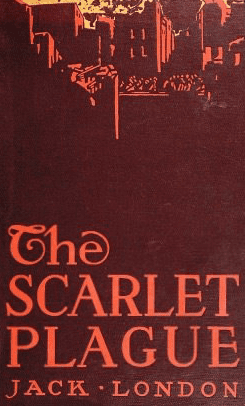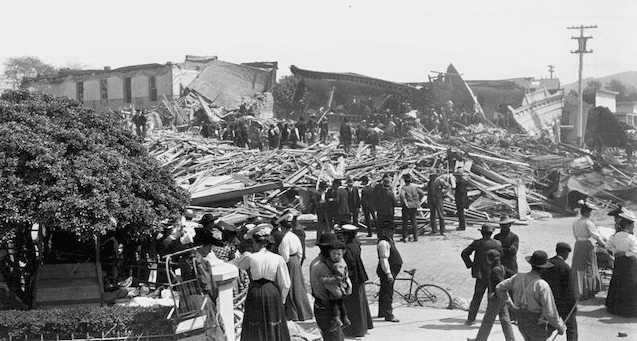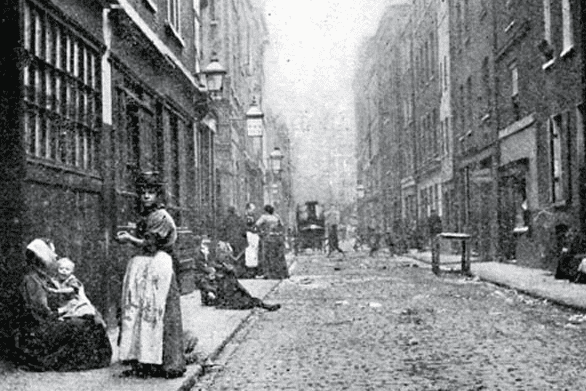Edward McSweegan
Kingston, Rhode Island, United States
 |
| The Scarlet Plague, by Jack London. Open Library, an initiative of the Internet Archive. |
The COVID-19 pandemic has given quarantined readers new opportunities to discover the literature of plagues and epidemics. Many people—in order to give context to the present pandemic—have turned to books like Albert Camus’ classic novel The Plague, Daniel DeFoe’s A Journal of the Plague Year, Steven King’s The Stand, and John Barry’s excellent history of the 1918 flu pandemic, The Great Influenza.1
House-bound readers also have rediscovered Jack London’s apocalyptic story, The Scarlet Plague. Published in 1912, the novel recounts a twenty-first-century plague that decimates California—and presumably the rest of the world—leaving only scattered tribes of illiterate survivors who are unlikely to ever resurrect all that has been lost. The rediscovered novel inspired some current commentators to imply that London was prescient, prompting them to ask, “Jack London saw this coming. Why didn’t we?”2 In fact, quite a few epidemiologists and infectious disease experts had suggested another pandemic was not only possible, but probable.3-5
Still others write, “London’s novel foresaw the first and most severe influenza pandemic in history, the Spanish influenza of 1918-1920, which began its spread only 6 years after the publication of The Scarlet Plague. . . .”6 London died two years before the influenza pandemic began and there is little evidence he was writing to predict a possible future. Rather, he was writing to highlight his own time, drawing on his own experiences to imagine stories that might awaken his fellow citizens to the precarious, contemporary world around them.
Jack London was in California during outbreaks of bubonic plague in San Francisco. In that dangerous city, a panicked public looked for scapegoats among the Chinese residents while the press and health officials struggled against local government and businesses determined to downplay the danger and present a false sense of business as usual.7
Six years later, in 1906, he witnessed the destruction of the city in a massive earthquake. Through the lens of his own camera he documented the fragility of modern civilization after a minute of ground tremors reduced San Francisco to rubble and conflagration and its prosperous citizens to homeless beggars. Equally homeless rats also caused new outbreaks of plague among the city’s stunned survivors.
 |
| Jack London Photographs and Negatives, Huntington Digital Library. Call No: JLP 479 Alb. 41. Source |
In 1908 he sailed to Hawaii and visited the leper colony on Molokai, where hundreds of patients lived in “involuntary isolation.”8 London was a compassionate observer of the colony and its inhabitants, writing, “. . . the awful horror with which the leper has been regarded in the past, and the frightful treatment he has received, have been unnecessary and cruel.”9
The following year he wrote a short story about a Hawaiian man who contracted leprosy (Hansen’s disease) and then resisted government efforts to deport him to the Molokai leper colony. “Koolau the Leper” is a fictional retelling of what became known in Hawaii as the Leper War on Kaua’i after the government sought to enforce the “Act to Prevent the Spread of Leprosy.”
There is nothing prescient about London’s non-fiction book The People of the Abyss. Written in 1903, it describes his time among the residents of London’s East End. “No other book of mine took so much of my young heart and tears,” he wrote. His friend Upton Sinclair added, “For years afterwards, the memories of this stunted and depraved population haunted him beyond all peace.”10 In describing this hell within Europe’s greatest city, Jack London felt compelled to mention disease fifteen times and filth ten times because “in such conditions the outlook for the children is hopeless. They die like flies. . . .”10
London did not need the gift of prophecy or even much imagination when he had before him the burned and broken wreckage of San Francisco, the corralled lepers of Hawaii, and the impoverished creatures of damp, dark Whitechapel. Where he is imaginative and predictive, however, he misses the bullseye. In Manchuria and Korea during the Russo-Japanese War, he had a front row seat to the horrors of a modern war on the Asian continent. That experience inspired the 1910 story “The Unparalleled Invasion,” in which Western airships drop biological weapons on the “disorganized mass of China” in the year 1976. He wrote, “Hundred-ton guns were toys compared with micro-organic projectiles hurled from laboratories.” But that imagined future in reality became Imperial Japan dropping plague-infected fleas over China beginning in 1940 and killing tens of thousands of people. China survived. Imperial Japan did not.11
 |
| Dorset Street in London’s notorious Whitechapel district, photographed in 1902 for The People of the Abyss. Source |
Last March, a writer for The New Yorker claimed, “London stole the red death from Poe [“The Masque of the Red Death”] and took the plot of The Scarlet Plague from [Shelley’s] The Last Man.12 Maybe. In 1912 the scope of apocalyptic literature was limited by global experience and by the technology and bacteriology of the day. Today we are enriched with a well-documented history of prior epidemics, recombinant DNA techniques, a menagerie of emerging viruses, terrorists, zombies, prions, and Andromedan molecules with which to launch a thousand plots.
If London borrowed something or was inspired by something, it may have been a 1902 Royal Institution lecture given by H.G. Wells.13 Wells and London knew each other and shared the cover of The Cosmopolitan’s November 1900 issue, along with other then-famous authors. In his lecture entitled “The Discovery of the Future” Wells said, “It is conceivable, too, that some pestilence may presently appear, some new disease, that will destroy, not 10 or 15 or 20 percent of the earth’s inhabitants as pestilences have done in the past, but 100 per cent.; and so end our race.”
Prophet, plagiarizer, or popularizer, Jack London left an impressive body of fiction, science fiction, frontline reporting, and muckraking. As the California columnist Joe Mathews recently wrote, “London’s larger message was even more prescient: In pandemics don’t be distracted by saving buildings and jobs. Prioritize saving as many humans as possible.”2
References
- Self J. Why people are turning to pandemic fiction to help process the Covid-19 crisis. Available at: https://bit.ly/3llpki0. Last accessed. October 7, 2020.
- Mathews J. What Jack London got right about COVID-19, 110 years ago. The Baltimore Sun, April 13, 2020. Available at: https://bit.ly/36LdcTo. Last accessed October 4, 2020.
- Myers MF, Rogers DJ, Cox J, Flahault A, Hay SI. Forecasting disease risk for increased epidemic preparedness in public health. Adv Parasitol. 2000;47:309-330.
- Taubenberger JK, Morens DM, Fauci AS. The next influenza pandemic: can it be predicted? JAMA. 2007;297(18):2025-2027. doi:10.1001/jama.297.18.2025
- Bloom DE., Cadarette D. Infectious Disease Threats in the Twenty-First Century: Strengthening the Global Response. Frontiers Immunol, March 28, 2019. doi.org/10.3389/fimmu.2019.00549
- Riva MA, Benedetti M, Cesana G. Pandemic fear and literature: observations from Jack London’s The Scarlet Plague. Emerg Infect Dis. 2014;20(10):1753-1757.
- Randall D.K. Black Death at the Golden Gate. New York, NY: W.W. Norton & Co. 2019.
- International Leprosy Association. Available at: https://bit.ly/34yNEGu. Last accessed October 8, 2020.
- The Lepers of Molokai. Woman’s Home Companion. January 1908. Available at: https://bit.ly/3lsjgED. Last accessed October 6, 2020.
- Ridgwell, J. Jack London’s journey into the abyss. The Guardian. Oct. 5, 2007. Available at: https://bit.ly/3iG2ZtJ. Last accessed October 5, 2020.
- Federation of American Scientists. Biological Weapons Program. Available at: https://fas.org/nuke/guide/japan/bw/. Last accessed October 4, 2020.
- Lepore, J. What Our Contagion Fables Are Really About. The New Yorker, March 23, 2020. Available at: https://bit.ly/2SAvqyD. Last accessed October 3, 2020.
- Wells, H.G. The Discovery of the Future. Nature, 1902;65(1684):326-331.
EDWARD MCSWEEGAN, Ph.D., is a microbiologist in Rhode Island. He worked at the National Institutes of Health in Bethesda and later at the Global Virus Network in Baltimore. He writes frequently about infectious diseases and history.
Highlighted in Frontispiece Volume 13, Issue 2– Spring 2021

Leave a Reply